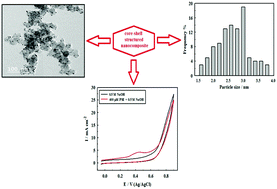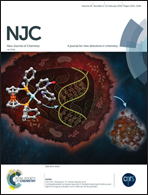A core–shell structured Ni–Co@Pt/C nanocomposite-modified sensor for the voltammetric determination of pseudoephedrine HCl
Abstract
Herein, a core–shell structured Ni–Co@Pt/C nanocomposite was developed for the determination of pseudoephedrine HCl (PSE) in drug samples. Different Ni–Co@Pt/C nanomaterials were fabricated by varying the Ni : Co atomic ratio using ethylene glycol as the reducing agent via an assisted microwave irradiation process. X-ray diffraction (XRD) and transmission electron microscopy (TEM) were conducted to characterize the prepared nanocomposite. Electrocatalytic activity of the Ni–Co@Pt/C nanocomposite for the determination of PSE was demonstrated using cyclic voltammetry, linear sweep voltammetry, differential pulse voltammetry, and electrochemical impedance spectroscopy. The PSE oxidation current density value was efficiently affected by the cobalt content in the fabricated Ni–Co@Pt/C nanocomposite. The maximum activity was achieved with the nanomaterial containing a Ni : Co atomic ratio of 1 : 3. Differential pulse voltammetry indicated a linear dependence of the oxidation current density on the PSE concentration up to 1400 μM. High sensitivity and good reproducibility and stability were displayed by the Ni–Co@Pt/C nanocomposite during the estimation of PSE. This would encourage the wide application of the proposed nanocomposite in the clinical assay of the studied drugs.


 Please wait while we load your content...
Please wait while we load your content...